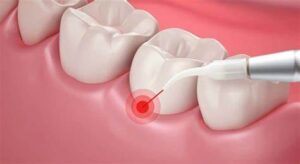What is it?
Gum disease, also known as periodontal disease, is a common oral health condition characterized by inflammation and infection of the gums and surrounding tissues. If left untreated, gum disease can lead to serious complications, including tooth loss and systemic health issues. Here’s an overview of gum disease treatment and its key aspects:
- Early Detection and Diagnosis:
- Early detection of gum disease is crucial for successful treatment and prevention of further progression.
- During a dental examination, the dentist or dental hygienist will assess the health of your gums, measure periodontal pockets (spaces between the gums and teeth), and look for signs of inflammation, bleeding, or gum recession.
- Diagnostic tests, such as dental X-rays or periodontal probing, may be performed to evaluate the extent of gum disease and identify any underlying bone loss.
- Non-Surgical Treatments:
- In the early stages of gum disease (gingivitis), non-surgical interventions may be sufficient to control the infection and restore gum health:
- Professional Dental Cleaning: Thorough cleaning of the teeth and gums (scaling and root planing) to remove plaque, tartar (calculus), and bacteria from above and below the gumline.
- Oral Hygiene Education: Instruction on proper brushing and flossing techniques, as well as the use of antimicrobial mouth rinses or interdental cleaning aids to maintain oral hygiene at home.
- Antibacterial Therapy: Prescription or over-the-counter antimicrobial agents, such as mouth rinses or gels containing chlorhexidine or prescription antibiotics, may be recommended to reduce bacterial plaque and inflammation.
- Lifestyle Modifications: Encouragement to quit smoking, manage stress, eat a balanced diet, and adopt healthy lifestyle habits to support gum health and overall well-being.
- Surgical Treatments:
- In cases of advanced gum disease (periodontitis) or when non-surgical methods are insufficient, surgical interventions may be necessary to address deep pockets, gum recession, and tissue damage:
- Pocket Reduction Surgery (Flap Surgery): Surgical removal of diseased gum tissue and bacteria from periodontal pockets, followed by reshaping and suturing of the gums to eliminate pockets and promote tissue reattachment.
- Gum Grafting: Transfer of healthy gum tissue from one area of the mouth (usually the palate) to areas with gum recession to cover exposed tooth roots and enhance gum aesthetics and stability.
- Bone Grafting: Placement of bone graft material to regenerate lost bone support and restore the integrity of the jawbone damaged by periodontal disease.
- Guided Tissue Regeneration (GTR): Placement of biocompatible membranes or grafting materials to encourage the regeneration of bone and periodontal tissues lost due to gum disease.
- Maintenance and Follow-Up Care:
- After gum disease treatment, regular maintenance and ongoing periodontal therapy are essential to prevent disease recurrence and maintain long-term oral health:
- Periodontal Maintenance Visits: Scheduled follow-up appointments with the dental hygienist for professional cleaning, monitoring of periodontal health, and reinforcement of oral hygiene instructions.
- Periodontal Monitoring: Routine periodontal examinations and assessments to monitor the stability of gum health, evaluate the effectiveness of treatment, and identify any signs of disease recurrence or progression.
- Collaboration with Specialists: Referral to periodontists (gum specialists) or other dental specialists for complex cases or advanced treatments requiring specialized expertise.
- Systemic Health Considerations:
- Research has shown that gum disease is associated with an increased risk of systemic health conditions, such as cardiovascular disease, diabetes, respiratory infections, and adverse pregnancy outcomes.
- Treating gum disease may contribute to improved overall health and well-being by reducing inflammation, lowering systemic inflammation markers, and potentially lowering the risk of associated systemic diseases.
In summary, gum disease treatment aims to control infection, reduce inflammation, restore gum health, and prevent further damage to the teeth and supporting structures. By implementing appropriate treatment strategies, practicing good oral hygiene, and receiving ongoing professional care, individuals can manage gum disease effectively and maintain optimal oral health for a lifetime.

